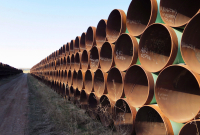Support strong Canadian climate journalism for 2025
The federal government’s newly-released strategy to slash planet-warming emissions from Canada’s buildings commits to phasing out heating oil in new buildings.
Two years ago, the federal government set out to create a strategy to achieve a 37 per cent cut below 2005 levels in direct building emissions by the end of 2030, reaching net-zero in 2050. Published Tuesday, the Canada Green Buildings Strategy is the result of that work.
But some advocates say it doesn’t deliver.
“The strategy contains neither the mandatory performance standards nor public investments needed to achieve net-zero emissions, and that was the reason for producing a strategy in the first place,” said Brendan Haley, policy director at Efficiency Canada, in a phone interview with Canada’s National Observer.
Buildings account for 18 per cent of Canada’s greenhouse gas emissions making it the third largest sector emitting greenhouse gas after oil and gas and transportation.
“Cutting the wasted energy from the heating and cooling of our buildings is a win-win, both for lower energy bills and less harmful pollution going into our atmosphere,” said federal environment and climate change minister Steven Guilbeault in a press release. “Already in Canada, we have seen a tidal shift in the adoption of heat pumps at a household level, as well as clean energy solutions for large commercial buildings and industry.”
Decarbonizing the building sector is a monumental task. Nearly 16.6 million existing buildings need upgrades. And there’s a high demand for housing in the immediate future. (Canada’s National Observer is breaking down the challenges and opportunities in a new series, Big Green Build.)
More than 96 per cent of buildings’ emissions come from space- and water heating powered by fossil fuels, so electrifying heating is key, according to the strategy.
The move away from heating oil was applauded by environmental groups and think tanks. However, the strategy’s pace of change is too slow, and doesn’t have a clear implementation plan, Ollie Sheldrick, program manager at Clean Energy Canada, said in a written statement.
Haley noted phasing out heating oil in new buildings doesn’t address its use in existing buildings.
The strategy said it will introduce a “regulatory framework” to ban expensive and polluting oil heating as early as 2028. It is unclear what avenue the federal government will use to regulate this, but some regions are ahead of the curve — Quebec, for one, banned oil heating in new builds in 2021 — so any federal regulations would act as a backstop.
Natural gas is a mainstay for heating buildings in Canada — this fuel is present in 60 per cent of all existing commercial and institutional buildings, the strategy noted.
While it addresses oil in new buildings, “there's nothing in the strategy that suggests a policy is coming to actually limit the use of gas in new buildings,” Stand.earth climate campaigner Lana Goldberg told Canada’s National Observer.
“By neglecting to develop a policy to address ‘natural’ gas in new buildings, the plan ignores the elephant in the room,” Goldberg said.
“We are very far from reaching our building emission reduction targets and have even seen building emissions rise in recent years,” Goldberg said. “If we build millions of new homes with gas furnaces, we will needlessly increase emissions, and new homeowners and renters will miss out on having lower monthly energy bills. The solution is simple: Build homes green from the start.”
The strategy also includes ongoing and recently announced federal initiatives to accelerate home and building retrofits, lower energy bills with heat pumps, use lower carbon construction material and update energy efficiency regulations.
The plan particularly emphasizes the role of heat pumps, noting that unlike air conditioners, they can both heat and cool buildings.
Vancouver has a policy that requires heat pumps installed in place of air conditioners in all new detached one- or two-family homes. Efficiency Canada and other like-minded organizations have pushed the federal government to adopt this “win-win” policy, citing significant cost savings in a report last year, but the new strategy stops short of this.
350 Canada is calling for a universal heat pump program to ensure every residence is equipped with one, particularly in the face of sweltering summer heat that proved deadly for 619 people during the 2021 heat dome in B.C.
The federal government does have a program to help Atlantic Canadians get a free heat pump to ditch heating oil, and other programs to help homeowners with retrofits, but advocates want heat pumps for everyone.
Equitable access to cooling through clean, cheap heat pumps could have prevented B.C.’s tragic loss of life, said Atiya Jaffar, 350 Canada team lead, in response to the new federal strategy.
In 2023, nearly 36 per cent of the lowest-income households did not have access to air conditioning and approximately 18 per cent had a hard time maintaining safe and comfortable indoor temperatures due to increasing energy costs, according to the federal government. Consequently, around two per cent of Canadian households said they needed medical assistance for someone in their home because of these living conditions, according to the strategy.
Budget 2024 has already announced $800 million over five years to launch a new home retrofit program starting in 2025 and targeting low- to median-income households. The Canada Greener Homes Affordability Program is replacing the federal government’s popular $2.6-billion Canada Greener Homes grant, which ran out of funding earlier this year.
As of May 1, nearly 125,000 heat pumps have been installed with federal support across Canada, according to the strategy.
However, the plan provides “no clear pathway to get away from these short-term boom-bust programs,” Haley said, referencing the uncertainty caused when a program ends and isn’t immediately refunded or replaced, like the former Greener Homes Grant.
At the current pace, it would take 170 years to retrofit all the residential buildings in Canada, according to the strategy. The federal government said $400 billion in capital investment is required over the next 30 years to increase the pace and put the goal of net-zero by 2050 within reach.
Natasha Bulowski / Local Journalism Initiative / Canada’s National Observer






Comments
Does anyone actually install oil heating anymore? Sounds about as useful as banning new coal fired kitchen stoves.
Exactly what I was thinking. Talk about your symbolic policies.
I live in a relatively poor rural community in Northern Ontario.
Yes. People install oil heat. It's cheaper than the alternatives.
Our illustrious Premier developed a planny plan a couple of years ago, supporting purchase and installation of heat pumps. Of course, the "support" didn't come anywhere near the cost.
And the only authorized source was one of his corporate cronies.